

Compact Muon Solenoid
LHC, CERN
| CMS-HIN-16-010 ; CERN-EP-2016-147 | ||
| Evidence for collectivity in pp collisions at the LHC | ||
| CMS Collaboration | ||
| 20 June 2016 | ||
| Phys. Lett. B 765 (2017) 193 | ||
| Abstract: Measurements of two- and multi-particle angular correlations in pp collisions at $\sqrt{s} = $ 5, 7, and 13 TeV are presented as a function of charged-particle multiplicity. The data, corresponding to integrated luminosities of 1.0 pb$^{-1}$ (5 TeV), 6.2 pb$^{-1}$ (7 TeV), and 0.7 pb$^{-1}$ (13 TeV), were collected using the CMS detector at the LHC. The second-order ($v_2$) and third-order ($v_3$) azimuthal anisotropy harmonics of unidentified charged particles, as well as $v_2$ of $\mathrm{ K_S }^0$ and $\Lambda/\overline{\Lambda}$ particles, are extracted from long-range two-particle correlations as functions of particle multiplicity and transverse momentum. For high-multiplicity pp events, a mass ordering is observed for the $v_2$ values of charged hadrons (mostly pions), $\mathrm{ K_S }^0$, and $\Lambda/\overline{\Lambda}$, with lighter particle species exhibiting a stronger azimuthal anisotropy signal below $p_{\mathrm{T}} \approx 2$ GeV/$c$. For 13 TeV data, the $v_2$ signals are also extracted from four- and six-particle correlations for the first time in pp collisions, with comparable magnitude to those from two-particle correlations. These observations are similar to those seen in pPb and PbPb collisions, and support the interpretation of a collective origin for the observed long-range correlations in high-multiplicity pp collisions. | ||
| Links: e-print arXiv:1606.06198 [hep-ex] (PDF) ; CDS record ; inSPIRE record ; HepData record ; CADI line (restricted) ; | ||
| Figures & Tables | Summary | Additional Figures | References | CMS Publications |
|---|
| Figures | |
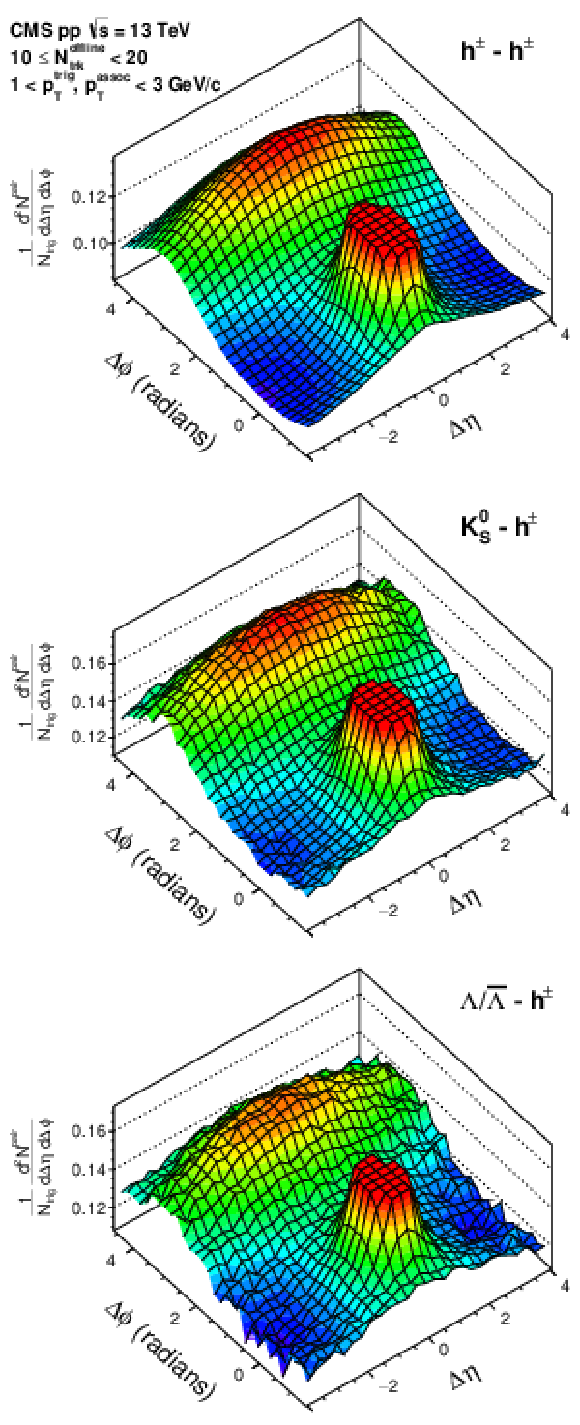
png pdf |
Figure 1-a:
The 2D two-particle correlation functions for inclusive charged particles (top), $\mathrm{ K_S }^0 $ particles (middle), and $ \Lambda /\overline{\Lambda} $ particles (bottom), with 1 $ < { {p_{\mathrm {T}}} ^{\text {trig}}} <$ 3 GeV/$c$ and associated charged particles with 1 $ < { {p_{\mathrm {T}}} ^{\text {assoc}}} < $ 3 GeV/$c$, in low-multiplicity (10 $ \leq {N_\text {trk}^\text {offline}} < $ 20) pp collisions at $ {\sqrt {s}} = $ 13 TeV. |
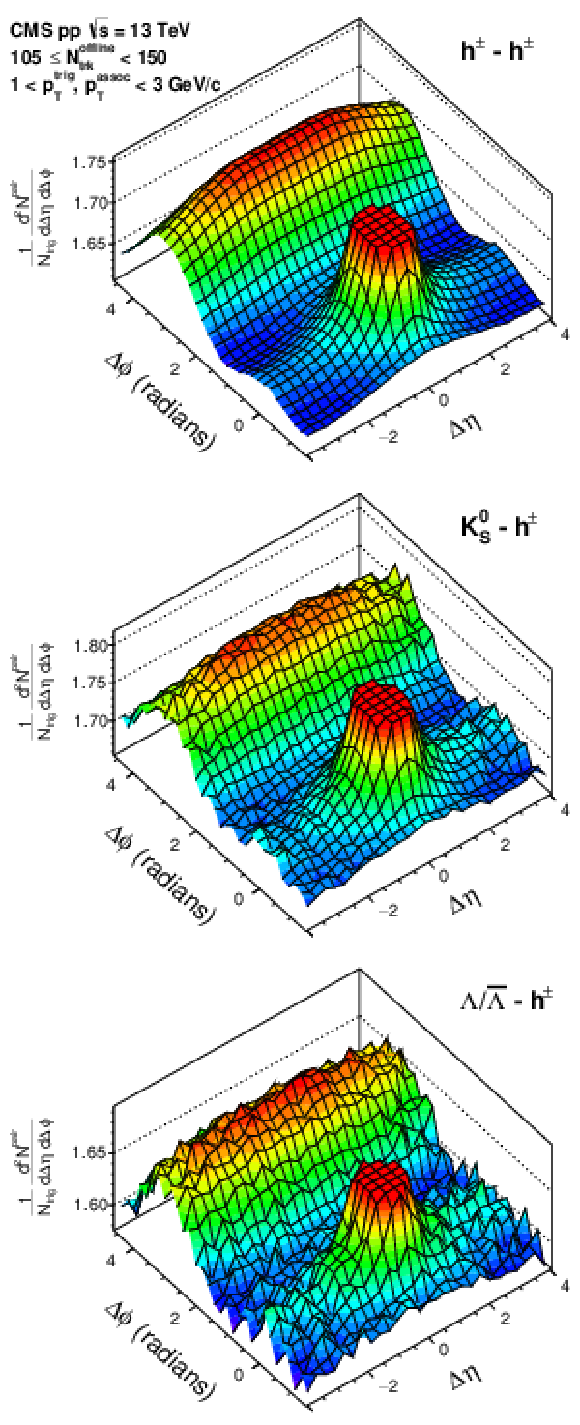
png pdf |
Figure 1-b:
The 2D two-particle correlation functions for inclusive charged particles (top), $\mathrm{ K_S }^0 $ particles (middle), and $ \Lambda /\overline{\Lambda} $ particles (bottom), with 1 $ < { {p_{\mathrm {T}}} ^{\text {trig}}} <$ 3 GeV/$c$ and associated charged particles with 1 $ < { {p_{\mathrm {T}}} ^{\text {assoc}}} < $ 3 GeV/$c$, in high-multiplicity (105 $ \leq {N_\text {trk}^\text {offline}} < $ 150) pp collisions at $ {\sqrt {s}} = $ 13 TeV. |
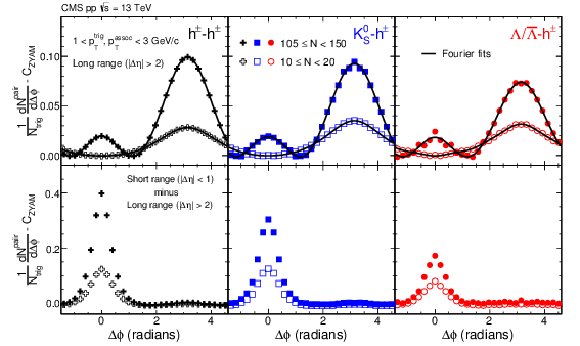
png pdf |
Figure 2:
The 1D ${\Delta \phi }$ correlation functions for the long-range (top) and short- minus long-range (bottom) regions after applying the ZYAM procedure in the multiplicity range 10 $ \leq {N_\text {trk}^\text {offline}} < $ 20 (open symbols) and 105 $ \leq {N_\text {trk}^\text {offline}} < $ 150 (filled symbols) of pp collisions at $ {\sqrt {s}} = $ 13 TeV, for trigger particles composed of inclusive charged particles (left, crosses), $\mathrm{ K_S }^0 $ particles (middle, squares), and $ \Lambda /\overline{\Lambda} $ particles (right, circles). A selection of 1-3 {GeV/$c$} \ for both ${ {p_{\mathrm {T}}} ^{\text {trig}}} $ and ${ {p_{\mathrm {T}}} ^{\text {assoc}}} $ is used in all cases. |

png pdf |
Figure 3:
The 1D ${\Delta \phi }$ correlation functions for the long-range regions in the multiplicity range 105 $ \leq {N_\text {trk}^\text {offline}} < $ 150 of pp collisions at $ {\sqrt {s}} = $ 13 TeV, after subtracting scaled results from 10 $ \leq {N_\text {trk}^\text {offline}} < $ 20 with the ZYAM procedure applied. A selection of 1-3 GeV/$c$ for both ${ {p_{\mathrm {T}}} ^{\text {trig}}} $ and ${ {p_{\mathrm {T}}} ^{\text {assoc}}} $ is used in all cases. |
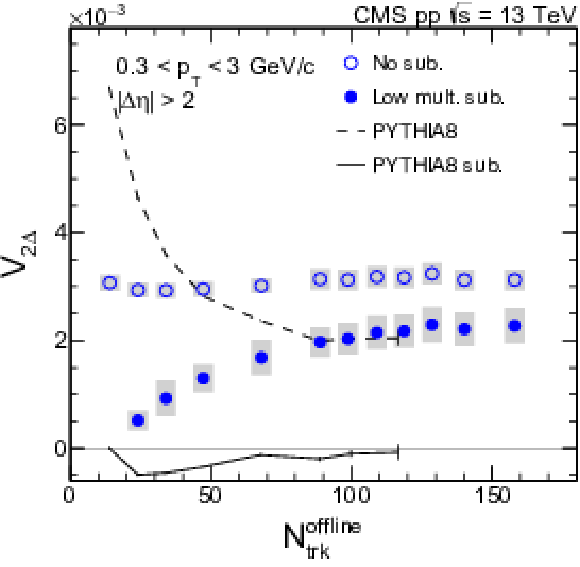
png pdf |
Figure 4-a:
The third-order Fourier coefficients, $V_{3\Delta }$, of long-range ($ {| {\Delta \eta } | }> $ 2 ) two-particle ${\Delta \phi }$ correlations as a function of ${N_\text {trk}^\text {offline}}$ for charged particles, averaged over 0.3 $ < {p_{\mathrm {T}}} <$ 3.0 GeV/$c$, in pp collisions at $ {\sqrt {s}} = $ 13 TeV, before (open) and after (filled) correcting for back-to-back jet correlations, estimated from the 10 $ \leq {N_\text {trk}^\text {offline}} < $ 20 range. Results from PYTHIA-8 tune CUETP8M1 simulation are shown as curves. The error bars correspond to statistical uncertainties, while the shaded areas denote the systematic uncertainties. |
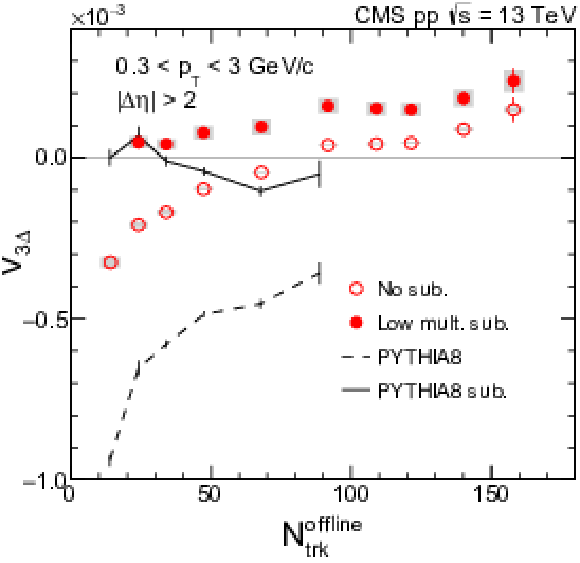
png pdf |
Figure 4-b:
The third-order Fourier coefficients, $V_{3\Delta }$, of long-range ($ {| {\Delta \eta } | }> $ 2 ) two-particle ${\Delta \phi }$ correlations as a function of ${N_\text {trk}^\text {offline}}$ for charged particles, averaged over 0.3 $ < {p_{\mathrm {T}}} <$ 3.0 GeV/$c$, in pp collisions at $ {\sqrt {s}} = $ 13 TeV, before (open) and after (filled) correcting for back-to-back jet correlations, estimated from the 10 $ \leq {N_\text {trk}^\text {offline}} < $ 20 range. Results from PYTHIA-8 tune CUETP8M1 simulation are shown as curves. The error bars correspond to statistical uncertainties, while the shaded areas denote the systematic uncertainties. |
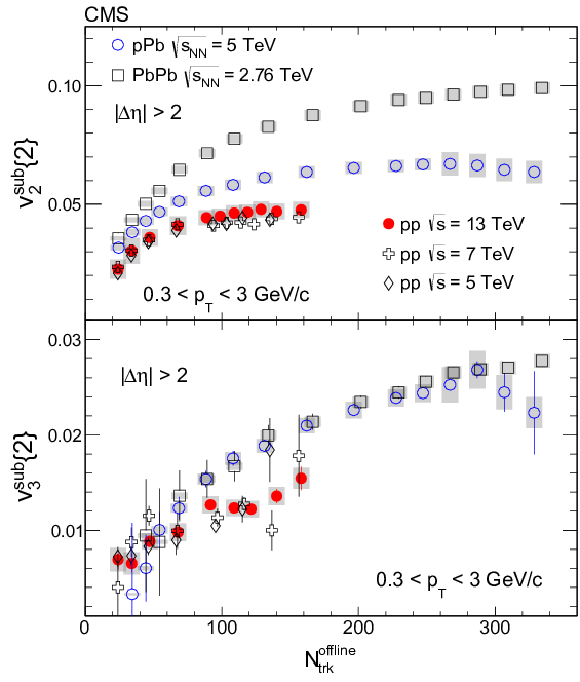
png pdf |
Figure 5:
The $v_{2}^\text {sub}$ (top) and $v_{3}^\text {sub}$ (bottom) results of charged particles as a function of ${N_\text {trk}^\text {offline}} $, averaged over 0.3 $ < {p_{\mathrm {T}}} <$ 3.0 GeV/$c$, in pp collisions at $ {\sqrt {s}} = $ 5, 7, and 13 TeV, pPb collisions at $ {\sqrt {s_{_\mathrm {NN}}}} = $ 5 TeV, and PbPb collisions $ {\sqrt {s_{_\mathrm {NN}}}} = $ 2.76 TeV, after correcting for back-to-back jet correlations estimated from low-multiplicity data. The error bars correspond to the statistical uncertainties, while the shaded areas denote the systematic uncertainties. Systematic uncertainties are found to have no dependence on ${\sqrt {s}}$ for pp results and therefore are only shown for 13 TeV. |
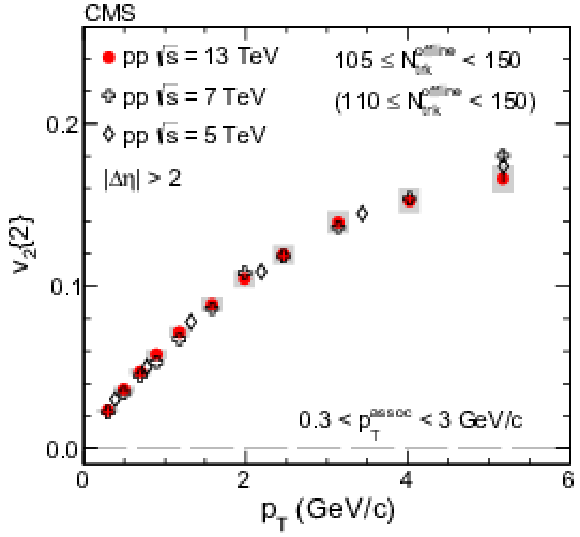
png pdf |
Figure 6-a:
The $v_2$ results of inclusive charged particles, before subtracting correlations from low-multiplicity events, as a function of ${p_{\mathrm {T}}}$ in pp collisions at $ {\sqrt {s}} = $ 13 TeV for 105 $ \leq {N_\text {trk}^\text {offline}} < $ 150 and at $ {\sqrt {s}} = $ 5, 7 TeV for 110 $ \leq {N_\text {trk}^\text {offline}} < $ 150. The error bars correspond to the statistical uncertainties, while the shaded areas denote the systematic uncertainties. Systematic uncertainties are found to have no dependence on $\sqrt {s}$ for pp results and therefore are only shown for 13 TeV. |
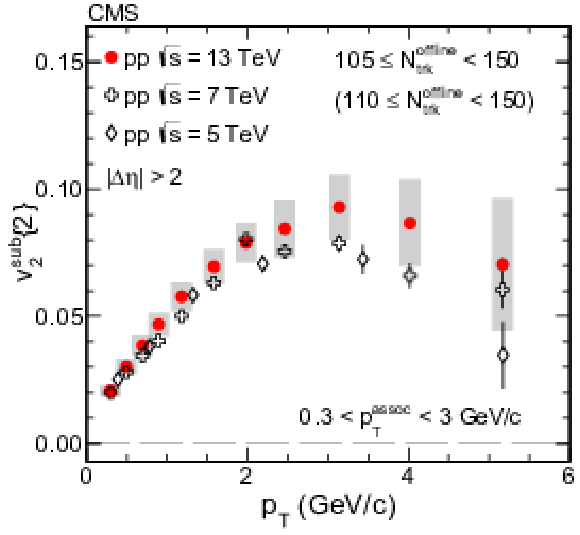
png pdf |
Figure 6-b:
The $v_2$ results of inclusive charged particles, after subtracting correlations from low-multiplicity events, as a function of ${p_{\mathrm {T}}}$ in pp collisions at $ {\sqrt {s}} = $ 13 TeV for 105 $ \leq {N_\text {trk}^\text {offline}} < $ 150 and at $ {\sqrt {s}} = $ 5, 7 TeV for 110 $ \leq {N_\text {trk}^\text {offline}} < $ 150. The error bars correspond to the statistical uncertainties, while the shaded areas denote the systematic uncertainties. Systematic uncertainties are found to have no dependence on $\sqrt {s}$ for pp results and therefore are only shown for 13 TeV. |
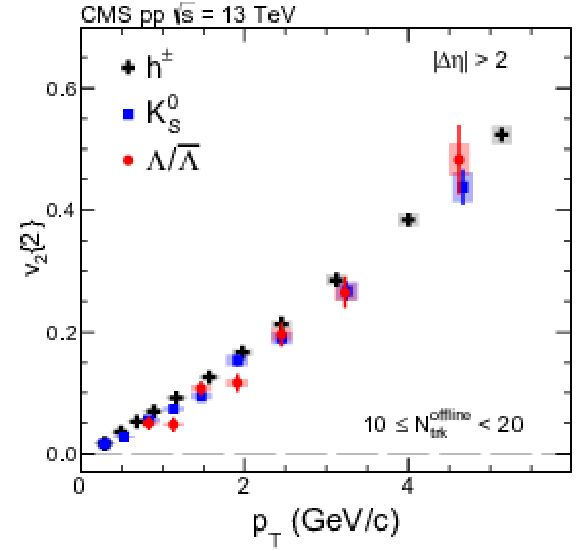
png pdf |
Figure 7-a:
The $v_2$ results for inclusive charged particles, $\mathrm{ K_S }^0 $ and $ \Lambda /\overline{\Lambda} $ particles as a function of ${p_{\mathrm {T}}}$ in pp collisions at $ {\sqrt {s}} = $ 13 TeV, for 10 $ \leq {N_\text {trk}^\text {offline}} < $ 20. The error bars correspond to the statistical uncertainties, while the shaded areas denote the systematic uncertainties. |
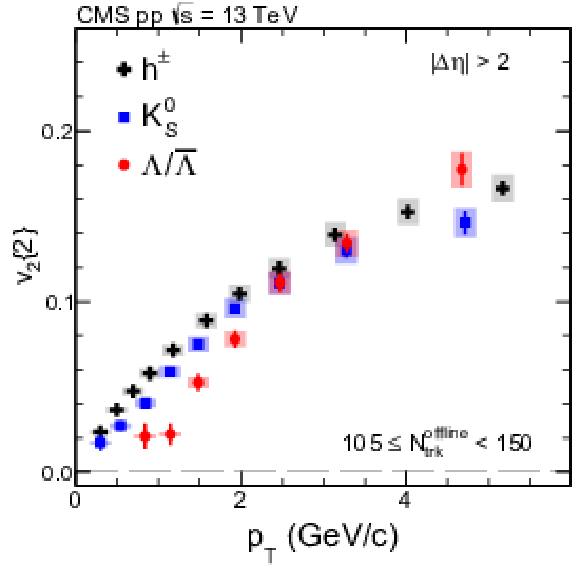
png pdf |
Figure 7-b:
The $v_2$ results for inclusive charged particles, $\mathrm{ K_S }^0 $ and $ \Lambda /\overline{\Lambda} $ particles as a function of ${p_{\mathrm {T}}}$ in pp collisions at $ {\sqrt {s}} = $ 13 TeV, for 105 $ \leq {N_\text {trk}^\text {offline}} < $ 150. The error bars correspond to the statistical uncertainties, while the shaded areas denote the systematic uncertainties. |
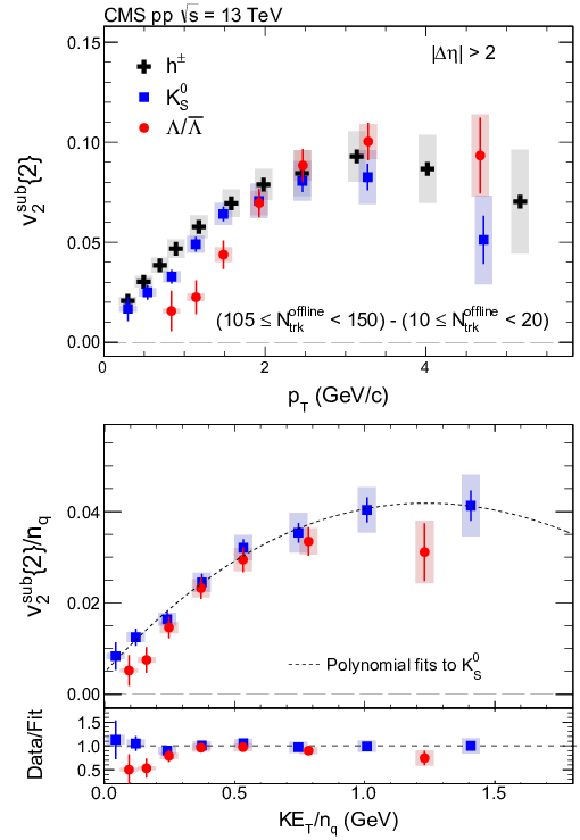
png pdf |
Figure 8:
Top: the $v_{2}^\text {sub}$ results of inclusive charged particles, $\mathrm{ K_S }^0 $ and $ \Lambda /\overline{\Lambda} $ particles as a function of ${p_{\mathrm {T}}}$ for 105 $ \leq {N_\text {trk}^\text {offline}} < $ 150, after correcting for back-to-back jet correlations estimated from low-multiplicity data. Bottom: the $n_\mathrm {q}$-scaled $v_{2}^\text {sub}$ results for $\mathrm{ K_S }^0 $ and $ \Lambda /\overline{\Lambda} $ particles as a function of $ {KE_{\mathrm {T}}} /n_\mathrm {q}$. Ratios of $v_{2}^\text {sub}/n_\mathrm {q}$ for $\mathrm{ K_S }^0 $ and $ \Lambda /\overline{\Lambda} $ particles to a smooth fit function of data for $\mathrm{ K_S }^0 $ particles are also shown. The error bars correspond to the statistical uncertainties, while the shaded areas denote the systematic uncertainties. |
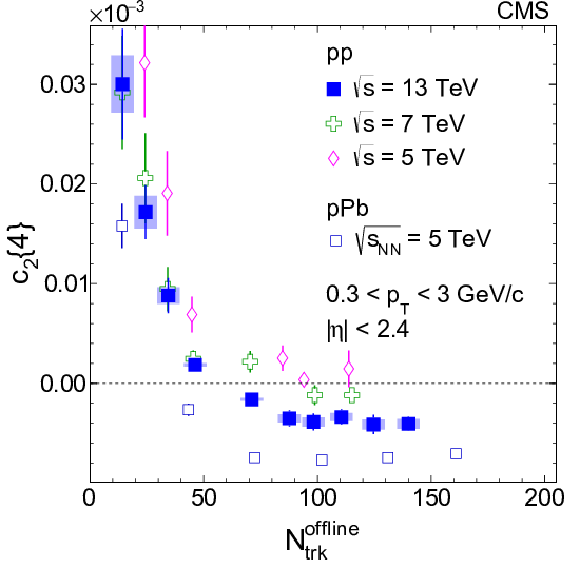
png pdf |
Figure 9-a:
The $c_{2}\{4\}$ values as a function of ${N_\text {trk}^\text {offline}}$ for charged particles, averaged over 0.3 $ < {p_{\mathrm {T}}} <$ 3.0 GeV/$c$ and $ {| \eta | }< $ 2.4, in pp collisions at $ {\sqrt {s}} = $ 5, 7, and 13 TeV. The pPb data at $ {\sqrt {s_{_\mathrm {NN}}}} = $ 5 TeV are also plotted for comparison. The error bars correspond to the statistical uncertainties, while the shaded areas denote the systematic uncertainties. Systematic uncertainties are found to have no dependence on ${\sqrt {s}}$ for pp results and therefore are only shown for 13 TeV. |
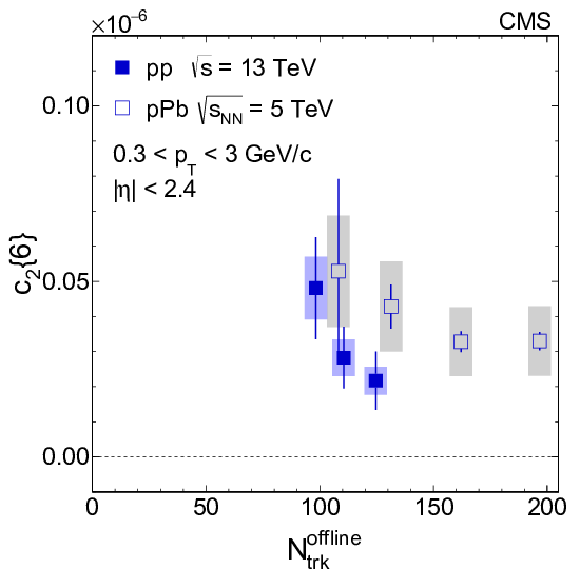
png pdf |
Figure 9-b:
The $c_{2}\{6\}$ values as a function of ${N_\text {trk}^\text {offline}}$ for charged particles, averaged over 0.3 $ < {p_{\mathrm {T}}} <$ 3.0 GeV/$c$ and $ {| \eta | }< $ 2.4, in pp collisions at $ {\sqrt {s}} = $ 5, 7, and 13 TeV. The pPb data at $ {\sqrt {s_{_\mathrm {NN}}}} = $ 5 TeV are also plotted for comparison. The error bars correspond to the statistical uncertainties, while the shaded areas denote the systematic uncertainties. Systematic uncertainties are found to have no dependence on ${\sqrt {s}}$ for pp results and therefore are only shown for 13 TeV. |
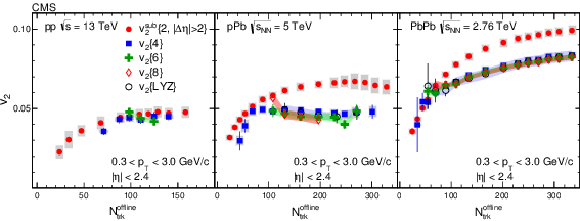
png pdf |
Figure 10:
Left: The $v_{2}^\text {sub}$, $v_{2}\{4\}$ and $v_{2}\{6\}$ values as a function of ${N_\text {trk}^\text {offline}}$ for charged particles, averaged over 0.3 $ < {p_{\mathrm {T}}} < $ 3.0 GeV/$c$ and $ {| \eta | }< $ 2.4, in pp collisions at $ {\sqrt {s}} = $ 13 TeV. Middle: The $v_{2}^\text {sub}$, $v_{2}\{4\}$, $v_{2}\{6\}$, $v_{2}\{8\}$, and $v_{2}\{\mathrm {LYZ}\}$ values in pPb collisions at $ {\sqrt {s_{_\mathrm {NN}}}} = $ 5 TeV [40]. Right: The $v_{2}^\text {sub}$, $v_{2}\{4\}$, $v_{2}\{6\}$, $v_{2}\{8\}$, and $v_{2}\{\mathrm {LYZ}\}$ values in PbPb collisions at $ {\sqrt {s_{_\mathrm {NN}}}} = $ 2.76 TeV [40]. The error bars correspond to the statistical uncertainties, while the shaded areas denote the systematic uncertainties. |
| Tables | |
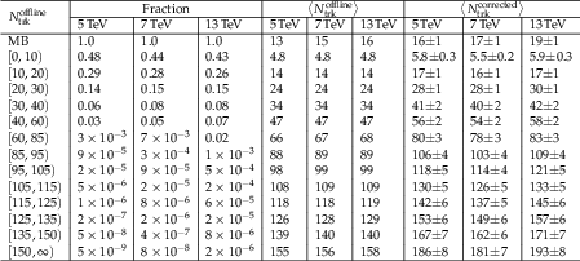
png pdf |
Table 1:
Fraction of MB triggered events after event selections in each multiplicity bin, and the average multiplicity of reconstructed tracks per bin with $ {| \eta | }< $ 2.4 and $ {p_{\mathrm {T}}} > $ 0.4 GeV/$c$, before ($ {N_\text {trk}^\text {offline}} $) and after ($N_\text {trk}^\text {corrected}$) efficiency correction, for pp data at $ {\sqrt {s}} = $ 5, 7, and 13 TeV. |

png pdf |
Table 2:
Summary of systematic uncertainties for multiplicity-dependent $v_{n}^\text {sub}\{2\}$ from two-particle correlations (after correcting for jet correlations), and $v_{2}\{4\}$, $v_{2}\{6\}$ from multi-particle correlations in pp collisions. Different multiplicity ranges are represented as $ [m,n)$. |
| Summary |
| The CMS detector has been used to measure two- and multi-particle azimuthal correlations with $\mathrm{ K_S }^0$, $\Lambda/\overline{\Lambda}$ and inclusive charged particles over a broad pseudorapidity and transverse momentum range in pp collisions at ${\sqrt{s}} = $ 5, 7, and 13 TeV. With the implementation of high-multiplicity triggers during the LHC 2010 and 2015 pp runs, the correlation data are explored over a broad particle multiplicity range. The observed long-range ($| {\Delta\eta} | > $ 2 ) correlations are quantified in terms of azimuthal anisotropy Fourier harmonics ($v_n$). The elliptic ($v_2$) and triangular ($v_3$) flow Fourier harmonics are extracted from long-range two-particle correlations. After subtracting contributions from back-to-back jet correlations estimated using low-multiplicity data, the $v_2$ and $v_3$ values are found to increase with multiplicity for ${N_\text{trk}^\text{offline}} \le $ 100, and reach a relatively constant value at higher values of ${N_\text{trk}^\text{offline}} $. The $ p_{\mathrm{T}} $ dependence of the $v_2$ harmonics in high-multiplicity pp events is found to have no or very weak dependence on the collision energy. In low-multiplicity events, similar $v_2$ values as a function of $ p_{\mathrm{T}} $ are observed for inclusive charged particles, $\mathrm{ K_S }^0$ and $\Lambda/\overline{\Lambda}$, possibly reflecting a common back-to-back jet origin of the correlations for all particle species. Moving to the higher-multiplicity region, a particle species dependence of $v_2$ is observed with and without correcting for jet correlations. For $p_{\mathrm{T}} \le$ 2 GeV/$c$, the $v_2$ of $\mathrm{ K_S }^0$ is found to be larger than that of $\Lambda/\overline{\Lambda}$. This behavior, which is consistent with predictions of hydrodynamic models, is similar to what was previously observed for identified particles produced in pPb and AA collisions at RHIC and the LHC. This mass ordering is reversed at higher $ p_{\mathrm{T}} $ values. Finally, $v_2$ signals based on four- and six-particle correlations are observed for the first time in pp collisions. The $v_2$ values obtained with two-, four-, and six-particle correlations at ${\sqrt{s}} = $ 13 TeV are found to be comparable within uncertainties. These observations provide strong evidence supporting the interpretation of a collective origin for the observed long-range correlations in high-multiplicity pp collisions. |
| Additional Figures | |
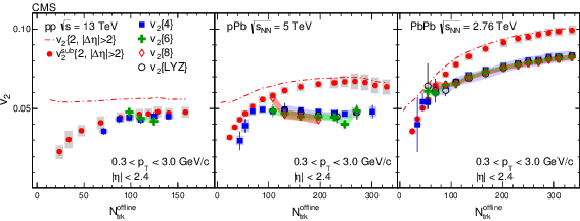
png pdf |
Additional Figure 1:
Left: The $v_{2}^\text {sub}$, $v_{2}\{4\}$ and $v_{2}\{6\}$ values as a function of ${N_\text {trk}^\text {offline}}$ for charged particles, averaged over 0.3 $< {p_{\mathrm {T}}} < $ 3.0 GeV/$c$ and $ {| \eta | }<$ 2.4, in pp collisions at $ {\sqrt {s}} = $ 13 TeV. Middle: The $v_{2}^\text {sub}$, $v_{2}\{4\}$, $v_{2}\{6\}$, $v_{2}\{8\}$, and $v_{2}\{\mathrm {LYZ}\}$ values in pPb collisions at $ {\sqrt {s_{_\mathrm {NN}}}} = $ 5 TeV [43]. Right: The $v_{2}^\text {sub}$, $v_{2}\{4\}$, $v_{2}\{6\}$, $v_{2}\{8\}$, and $v_{2}\{\mathrm {LYZ}\}$ values in PbPb collisions at $ {\sqrt {s_{_\mathrm {NN}}}} = $ 2.76 TeV [43]. $v_{2}\{2\}$ results without jet subtraction are shown as lines for all three collision systems. The error bars correspond to the statistical uncertainties, while the shaded areas denote the systematic uncertainties. |
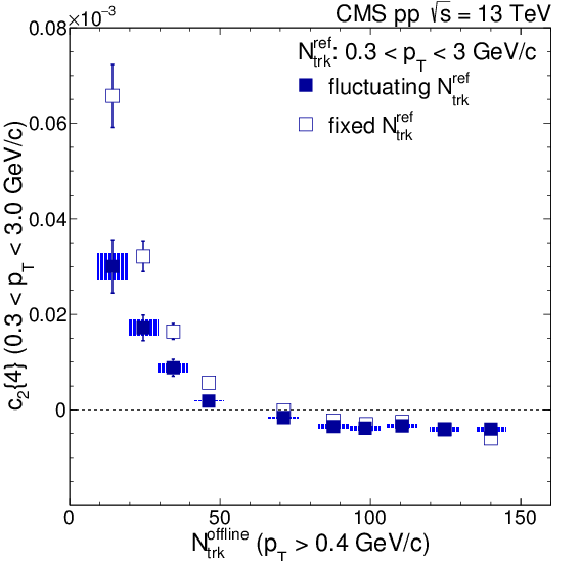
png pdf |
Additional Figure 2:
Comparison of $c_{2}\{4\}$ distributions when $N_{\mathrm {trk}}^{\mathrm {ref}}$ is not fixed (full squares) and fixed (open squares) as a function of ${N_\text {trk}^\text {offline}} $. |
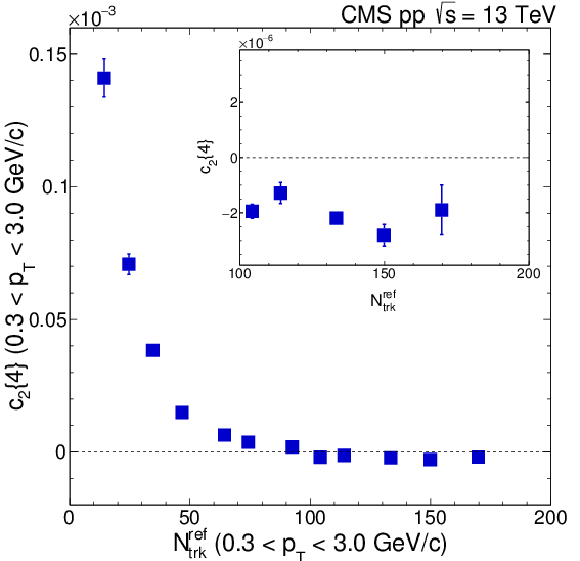
png pdf |
Additional Figure 3:
$c_{2}\{4\}$ distribution as a function of $N_{\mathrm {trk}}^{\mathrm {ref}}$ for the full $N_{\mathrm {trk}}^{\mathrm {ref}}$ range (full) and for high multiplicity region (insert). |
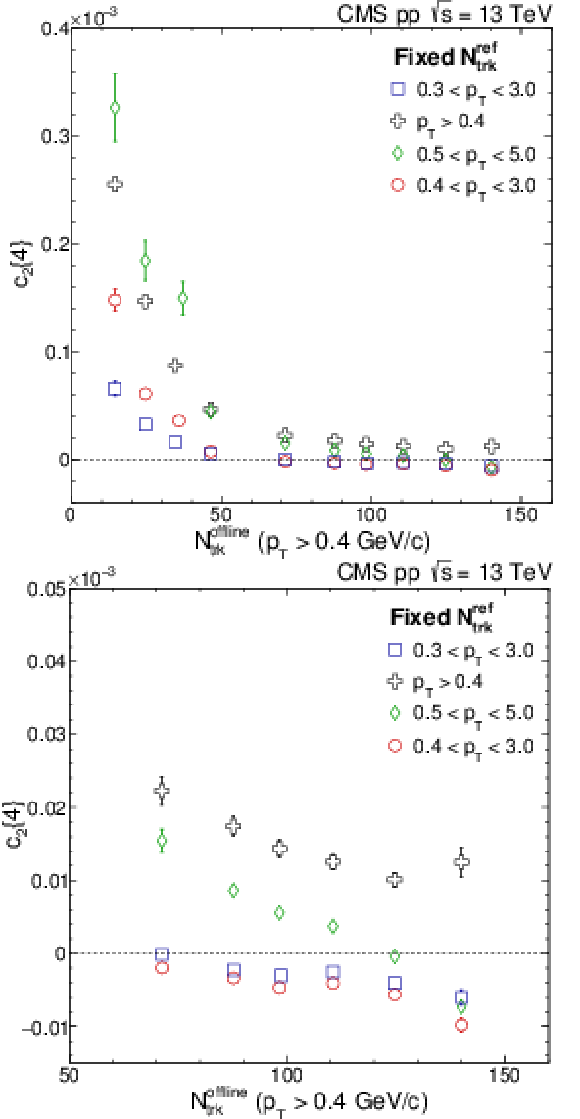
png pdf |
Additional Figure 4:
$c_{2}\{4\}$ distributions for different ${p_{\mathrm {T}}}$ range selections as a function of ${N_\text {trk}^\text {offline}} $. The $c_{2}\{4\}$ distributions are computed at fixed $N_{\mathrm {trk}}^{\mathrm {ref}}$. |
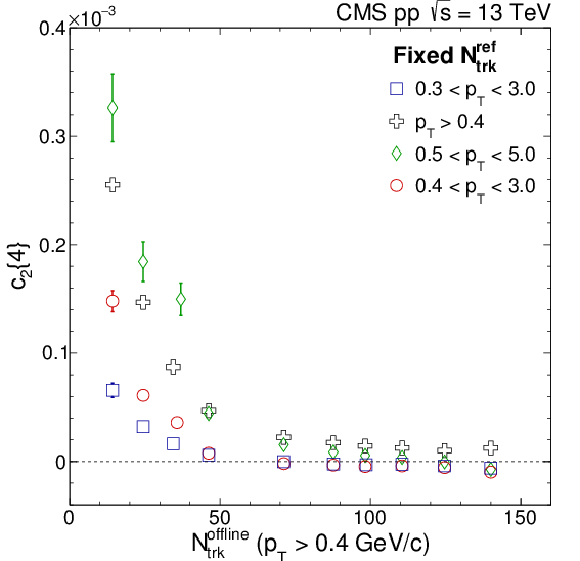
png pdf |
Additional Figure 4-a:
$c_{2}\{4\}$ distributions for different ${p_{\mathrm {T}}}$ range selections as a function of ${N_\text {trk}^\text {offline}} $. The $c_{2}\{4\}$ distributions are computed at fixed $N_{\mathrm {trk}}^{\mathrm {ref}}$. |
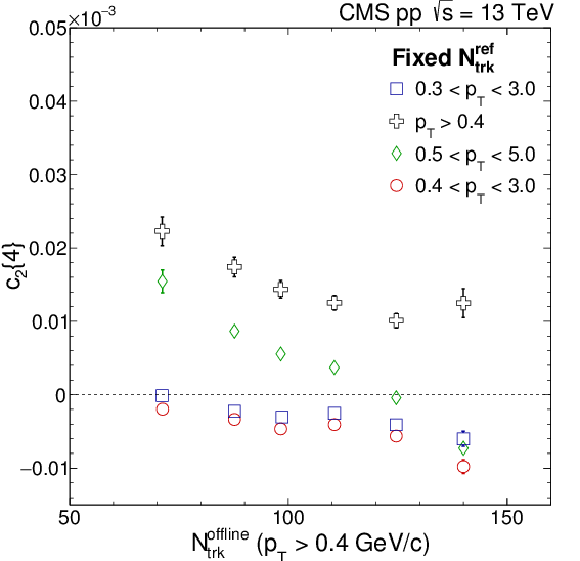
png pdf |
Additional Figure 4-b:
$c_{2}\{4\}$ distributions for different ${p_{\mathrm {T}}}$ range selections as a function of ${N_\text {trk}^\text {offline}} $. The $c_{2}\{4\}$ distributions are computed at fixed $N_{\mathrm {trk}}^{\mathrm {ref}}$. |
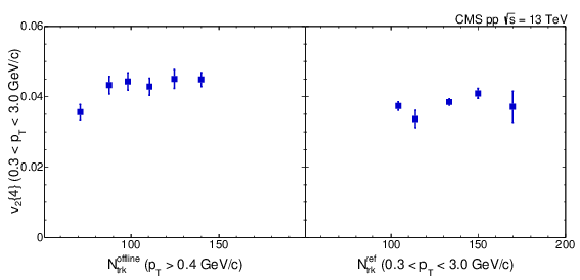
png pdf |
Additional Figure 5:
$v_{2}\{4\}$ as a function of ${N_\text {trk}^\text {offline}}$ (left) and $N_{\mathrm {trk}}^{\mathrm {ref}}$ (right). The results as a function of ${N_\text {trk}^\text {offline}}$ are the ones presented in the paper. |
| References | ||||
| 1 | CMS Collaboration | Observation of Long-Range Near-Side Angular Correlations in Proton-Proton Collisions at the LHC | JHEP 09 (2010) 091 | CMS-QCD-10-002 1009.4122 |
| 2 | ATLAS Collaboration | Observation of Long-Range Elliptic Azimuthal Anisotropies in $ \sqrt{s}= $ 13 and 2.76 TeV pp Collisions with the ATLAS Detector | PRL 116 (2016) 172301 | 1509.04776 |
| 3 | CMS Collaboration | Measurement of long-range near-side two-particle angular correlations in pp collisions at $ \sqrt s = $ 13 TeV | PRL 116 (2016) 172302 | CMS-FSQ-15-002 1510.03068 |
| 4 | CMS Collaboration | Observation of long-range near-side angular correlations in proton-lead collisions at the LHC | PLB 718 (2013) 795 | CMS-HIN-12-015 1210.5482 |
| 5 | ALICE Collaboration | Long-range angular correlations on the near and away side in pPb collisions at $ \sqrt{s_{\mathrm{NN}}} $ = 5.02 TeV | PLB 719 (2013) 29 | 1212.2001 |
| 6 | ATLAS Collaboration | Observation of Associated Near-Side and Away-Side Long-Range Correlations in $ \sqrt{s_{NN}} = 5.02 TeV $ Proton-Lead Collisions with the ATLAS Detector | PRL 110 (2013) 182302 | 1212.5198 |
| 7 | LHCb Collaboration | Measurements of long-range near-side angular correlations in $ \sqrt{s_{\mathrm{NN}}} $ = 5 TeV proton-lead collisions in the forward region | 1512.00439 | |
| 8 | PHOBOS Collaboration | System size dependence of cluster properties from two- particle angular correlations in Cu+Cu and Au+Au collisions at $ \sqrt{s_{\mathrm{NN}}} $ = 200$ GeV $ | PRC 81 (2010) 024904 | 0812.1172 |
| 9 | STAR Collaboration | Distributions of charged hadrons associated with high transverse momentum particles in pp and Au + Au collisions at $ \sqrt{s_{\mathrm{NN}}} $ = 200$ GeV $ | PRL 95 (2005) 152301 | nucl-ex/0501016 |
| 10 | STAR Collaboration | Long range rapidity correlations and jet production in high energy nuclear collisions | PRC 80 (2009) 064912 | 0909.0191 |
| 11 | PHOBOS Collaboration | High transverse momentum triggered correlations over a large pseudorapidity acceptance in Au+Au collisions at $ \sqrt{s_{\mathrm{NN}}} $ = 200$ GeV $ | PRL 104 (2010) 062301 | 0903.2811 |
| 12 | STAR Collaboration | Three-particle coincidence of the long range pseudorapidity correlation in high energy nucleus-nucleus collisions | PRL 105 (2010) 022301 | 0912.3977 |
| 13 | CMS Collaboration | Long-range and short-range dihadron angular correlations in central PbPb collisions at a nucleon-nucleon center of mass energy of 2.76 TeV | JHEP 07 (2011) 076 | CMS-HIN-11-001 1105.2438 |
| 14 | CMS Collaboration | Centrality dependence of dihadron correlations and azimuthal anisotropy harmonics in PbPb collisions at $ \sqrt{s_{\mathrm{NN}}} $ = 2.76 TeV | EPJC 72 (2012) 2012 | CMS-HIN-11-006 1201.3158 |
| 15 | ALICE Collaboration | Harmonic decomposition of two-particle angular correlations in Pb-Pb collisions at $ \sqrt{s_{\mathrm{NN}}} $ = 2.76 TeV | PLB 708 (2012) 249 | 1109.2501 |
| 16 | ATLAS Collaboration | Measurement of the azimuthal anisotropy for charged particle production in $ \sqrt{s_{\mathrm{NN}}} $ = 2.76 TeV lead-lead collisions with the ATLAS detector | PRC 86 (2012) 014907 | 1203.3087 |
| 17 | CMS Collaboration | Measurement of the elliptic anisotropy of charged particles produced in PbPb collisions at nucleon-nucleon center-of-mass energy = 2.76 TeV | PRC 87 (2013) 014902 | CMS-HIN-10-002 1204.1409 |
| 18 | CMS Collaboration | Studies of azimuthal dihadron correlations in ultra-central PbPb collisions at $ \sqrt{s_{\mathrm{NN}}} $ = 2.76 TeV | JHEP 02 (2014) 088 | CMS-HIN-12-011 1312.1845 |
| 19 | J.-Y. Ollitrault | Anisotropy as a signature of transverse collective flow | PRD 46 (1992) 229 | |
| 20 | U. Heinz and R. Snellings | Collective flow and viscosity in relativistic heavy-ion collisions | Ann. Rev. Nucl. Part. Sci. 63 (2013) 123 | 1301.2826 |
| 21 | C. Gale, S. Jeon, and B. Schenke | Hydrodynamic Modeling of Heavy-Ion Collisions | Int. J. Mod. Phys. A 28 (2013) 1340011 | 1301.5893 |
| 22 | S. Voloshin and Y. Zhang | Flow study in relativistic nuclear collisions by Fourier expansion of azimuthal particle distributions | Z. Phys. C 70 (1996) 665 | hep-ph/9407282 |
| 23 | B. Alver and G. Roland | Collision geometry fluctuations and triangular flow in heavy-ion collisions | PRC 81 (2010) 054905, , Erratum: [\DOI10.1103/PhysRevC.82.039903] | 1003.0194 |
| 24 | B. H. Alver, C. Gombeaud, M. Luzum, and J.-Y. Ollitrault | Triangular flow in hydrodynamics and transport theory | PRC 82 (2010) 034913 | 1007.5469 |
| 25 | B. Schenke, S. Jeon, and C. Gale | Elliptic and triangular flow in event-by-event D=3+1 viscous hydrodynamics | PRL 106 (2011) 042301 | 1009.3244 |
| 26 | Z. Qiu, C. Shen, and U. Heinz | Hydrodynamic elliptic and triangular flow in Pb-Pb collisions at $ \sqrt{s_{\mathrm{NN}}} $ = 2.76 TeV | PLB 707 (2012) 151 | 1110.3033 |
| 27 | PHENIX Collaboration | Measurement of long-range angular correlation and quadrupole anisotropy of pions and (anti)protons in central $ d $$ + $Au collisions at $ \sqrt{s_{\mathrm{NN}}} $ = 200 GeV | PRL 114 (2015) 192301 | 1404.7461 |
| 28 | STAR Collaboration | Long-range pseudorapidity dihadron correlations in $ d $+Au collisions at $ \sqrt{s_{\rm NN}}=200 $ GeV | PLB 747 (2015) 265 | 1502.07652 |
| 29 | PHENIX Collaboration | Measurements of elliptic and triangular flow in high-multiplicity $ ^{3} $He$ + $Au collisions at $ \sqrt{s_{\mathrm{NN}}} $ = 200 GeV | PRL 115 (2015) 142301 | 1507.06273 |
| 30 | W. Li | Observation of a 'Ridge' correlation structure in high multiplicity proton-proton collisions: A brief review | MPLA 27 (2012) 1230018 | 1206.0148 |
| 31 | J. D. Bjorken, S. J. Brodsky, and A. Scharff Goldhaber | Possible multiparticle ridge-like correlations in very high multiplicity proton-proton collisions | PLB 726 (2013) 344 | 1308.1435 |
| 32 | K. Dusling, W. Li, and B. Schenke | Novel collective phenomena in high-energy proton-proton and proton-nucleus collisions | Int. J. Mod. Phys. E 25 (2016) 1630002 | 1509.07939 |
| 33 | K. Dusling and R. Venugopalan | Explanation of systematics of CMS p+Pb high multiplicity di-hadron data at $ \sqrt{ s_{\mathrm{NN}} } =$ 5.02 TeV | PRD 87 (2013) 054014 | 1211.3701 |
| 34 | K. Dusling and R. Venugopalan | Evidence for BFKL and saturation dynamics from dihadron spectra at the LHC | PRD 87 (2013) 051502 | 1210.3890 |
| 35 | B. Schenke and R. Venugopalan | Eccentric protons? Sensitivity of flow to system size and shape in p+p, p+Pb and Pb+Pb collisions | PRL 113 (2014) 102301 | 1405.3605 |
| 36 | P. Bozek | Collective flow in p-Pb and d-Pb collisions at TeV energies | PRC 85 (2012) 014911 | 1112.0915 |
| 37 | P. Bozek and W. Broniowski | Correlations from hydrodynamic flow in pPb collisions | PLB 718 (2013) 1557 | 1211.0845 |
| 38 | ALICE Collaboration | Long-range angular correlations of pi, K and p in p--Pb collisions at $ \sqrt{s_{\mathrm{NN}}} $ = 5.02 TeV | PLB 726 (2013) 164 | 1307.3237 |
| 39 | CMS Collaboration | Long-range two-particle correlations of strange hadrons with charged particles in pPb and PbPb collisions at LHC energies | PLB 742 (2015) 200 | CMS-HIN-14-002 1409.3392 |
| 40 | CMS Collaboration | Evidence for collective multi-particle correlations in pPb collisions | PRL 115 (2015) 012301 | CMS-HIN-14-006 1502.05382 |
| 41 | ALICE Collaboration | Multiparticle azimuthal correlations in p-Pb and Pb-Pb collisions at the CERN Large Hadron Collider | PRC 90 (2014) 054901 | 1406.2474 |
| 42 | ATLAS Collaboration | Measurement with the ATLAS detector of multi-particle azimuthal correlations in p+Pb collisions at $ \sqrt{s_{\mathrm{NN}}} $ = 5.02 TeV | PLB 725 (2013) 60 | 1303.2084 |
| 43 | CMS Collaboration | Multiplicity and transverse momentum dependence of two- and four-particle correlations in pPb and PbPb collisions | PLB 724 (2013) 213 | CMS-HIN-13-002 1305.0609 |
| 44 | K. Werner et al. | Evidence for Flow from Hydrodynamic Simulations of pPb Collisions at 5.02 TeV from $ v_2 $ Mass Splitting | PRL 112 (2014) 232301 | 1307.4379 |
| 45 | P. Bozek, W. Broniowski, and G. Torrieri | Mass hierarchy in identified particle distributions in proton-lead collisions | PRL 111 (2013) 172303 | 1307.5060 |
| 46 | L. Yan and J.-Y. Ollitrault | Universal fluctuation-driven eccentricities in proton-proton, proton-nucleus and nucleus-nucleus collisions | PRL 112 (2014) 082301 | 1312.6555 |
| 47 | CMS Collaboration | Description and performance of track and primary-vertex reconstruction with the CMS tracker | JINST 9 (2014) P10009 | CMS-TRK-11-001 1405.6569 |
| 48 | CMS Collaboration | The CMS experiment at the CERN LHC | JINST 3 (2008) S08004 | CMS-00-001 |
| 49 | Geant4 Collaboration | Geant4---a simulation toolkit | Nucl. Instrum. and Meth. A 506 (2003) 250 | |
| 50 | T. Sj\"ostrand, S. Mrenna, and P. Skands | PYTHIA 6.4 physics and manual | JHEP 05 (2006) 026 | hep-ph/0603175 |
| 51 | T. Sj\"ostrand, S. Mrenna, and P. Skands | A brief introduction to PYTHIA 8.1 | Comp. Phys. Comm. 178 (2008) 852 | 0710.3820 |
| 52 | CMS Collaboration | Strange Particle Production in pp Collisions at $ \sqrt{s} = $ 0.9 and 7 TeV | JHEP 05 (2011) 064 | CMS-QCD-10-007 1102.4282 |
| 53 | A. Bilandzic, R. Snellings, and S. Voloshin | Flow analysis with cumulants: Direct calculations | PRC 83 (2011) 044913 | 1010.0233 |
| 54 | ATLAS Collaboration | Measurement of long-range pseudorapidity correlations and azimuthal harmonics in $ \sqrt{s_{NN}}=$ 5.02 TeV proton-lead collisions with the ATLAS detector | PRC 90 (2014) 044906 | 1409.1792 |
| 55 | ATLAS Collaboration | Measurement of the pseudorapidity and transverse momentum dependence of the elliptic flow of charged particles in lead-lead collisions at $ \sqrt{s_{\mathrm{NN}}} $ = 2.76 TeV with the ATLAS detector | PLB 707 (2012) 330 | 1108.6018 |
| 56 | ALICE Collaboration | Anisotropic flow of charged particles in Pb-Pb collisions at $ \sqrt{s_{\rm NN}}=5.02 $ TeV | PRL 116 (2016) 132302 | 1602.01119 |
| 57 | STAR Collaboration | Mass, quark-number, and $ \sqrt{s_{NN}} $ dependence of the second and fourth flow harmonics in ultra-relativistic nucleus-nucleus collisions | PRC 75 (2007) 054906 | nucl-ex/0701010 |
| 58 | PHENIX Collaboration | Deviation from quark-number scaling of the anisotropy parameter $ v_2 $ of pions, kaons, and protons in Au+Au collisions at $ \sqrt{s_{\mathrm{NN}}} $ = 200 GeV | PRC 85 (2012) 064914 | 1203.2644 |
| 59 | N. Borghini, P. M. Dinh, and J.-Y. Ollitrault | A new method for measuring azimuthal distributions in nucleus-nucleus collisions | PRC 63 (2001) 054906 | nucl-th/0007063 |
| 60 | G. J. Feldman and R. D. Cousins | A unified approach to the classical statistical analysis of small signals | PRD 57 (1998) 3873 | physics/9711021 |

|
Compact Muon Solenoid LHC, CERN |

|

|

|

|

|

|